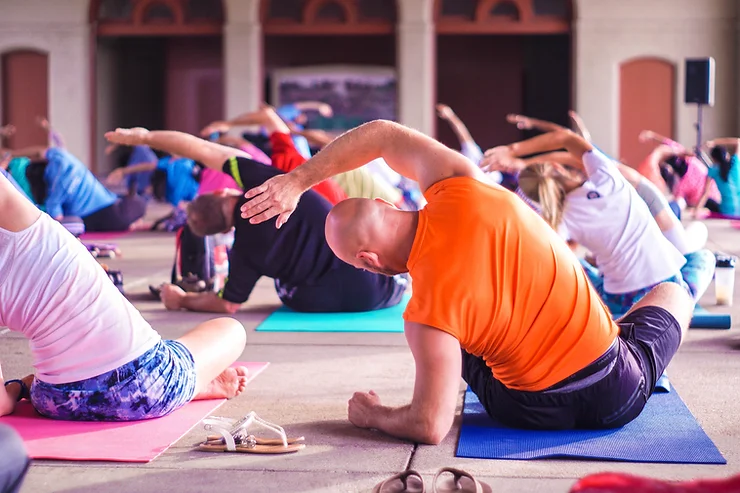You already know that your body requires regular exercise to be healthy … but are you incorporating a balance of the four fitness categories that Health Professionals encourage?
Physical activity is a spectrum of moves that target your body with individual benefits, and each kind of workout you do is beneficial to your health. However, to make the most out of the time you spend exercising, you should consider how each of these fitness categories fits into your workout plan. Together, they are the key to whole-body wellness.
What are the 4 fitness categories you should be incorporating into your fitness routine?
- Cardio workouts
- Muscle conditioning
- Weight-bearing exercises
- Stretching
Let’s dive into why each of them are important and how you’ll benefit from them.
How can you improve your cardiovascular system?
Cardio workouts, also referred to as cardiovascular exercise, are great to incorporate into your workout plan because of how they get your body moving and how fun they can be. They are an effective way to increase your heart rate for the purpose of improving your health. Aerobic exercises use oxygen and encourage blood circulation while burning off a substantial amount of calories.
Adding cardio workouts to your overall fitness plan will provide big benefits to your overall health according to Jeannie Glasstetter, a NASM CPT certified online fitness coach. She says, “It is important to strengthen your heart to help it more efficiently pump blood throughout the body.” According to a study by the NIH, other health benefits related to cardio workouts include better sleep, improved cardiorespiratory fitness, a decrease in risk of cardiovascular diseases and high blood sugar, and an extended life expectancy.
When it comes to cardio workouts, the options are nearly endless. Most physical activities that stimulate your breathing and heart rate to sustainably increased levels are considered a cardio exercise. If performed at the correct intensity, running, swimming, dancing, walking, skiing, skating, biking, rowing, or jumping jacks can all count. There are plenty of indoor cardio machines like ellipticals or treadmills that are also included as aerobic activities. Light-to-moderate intensity is the goal here.
The U.S. Department of Health recommends doing 150 minutes of cardio a week, however if you’re opting for a HIIT workout or circuit training, you can cut that recommendation in half to 75 minutes per week.
If you want to begin a cardio-focused fitness plan, it’s a great idea to start off with a certified personal trainer who can design a personalized training plan for you. They can show you the proper form for each of the exercises that are part of your workout plan to ensure you reduce your risk of injury and get the most out of your workouts. If you’re working with a personal trainer, you’ll probably be doing a lot of these types of cardio exercises:
- Squat jumps
- Burpees
- Medicine ball slams
- Mountain climbers
- High knees & butt kicks
- Kettlebell swings
- Plank jacks
- Jump rope
A personal trainer will keep your cardio workouts varied and challenging, so you definitely won’t get bored. Instead, you’ll keep motivated as you’re working toward your fitness goals.

How can the right workout plan strengthen your muscles?
Proper muscle conditioning helps make you stronger and involves a slightly higher level of intensity than cardio workouts. If your goal is muscle growth, then you should include around three sessions of twenty-minute strength workouts every week. Exercises are based on resistance and increase heart rate, burn fat, and aid in maintaining a healthy body.
Strength training includes the use of free weights, resistance bands or your own body weight to strengthen all major muscle groups, especially spinal muscles important for posture. There are significant health benefits to incorporating muscle conditioning workouts into your fitness routine. These include:
- Increased muscle mass: As you age, your muscle mass decreases. Adding strength training to your workouts on a regular basis can help reverse that trend.
- Weight control: As you gain muscle, your body will burn calories more easily. That makes weight management easier.
- Reduce falls, fractures and injuries: Stronger muscles can result in increased flexibility and balance which reduces the likelihood of falls and injuries. Additionally, strength training increases bone density. Stronger bones reduce your risk of fractures.
Any body-weight workouts can fall into this category, as well as digging, climbing, squats, lifting weights, sit-ups, lunges, running, and some sports. A lot of adults fall behind in this category so it’s important that you make an active effort to include these exercises weekly.
If you’re adding muscle conditioning exercises to your weekly workout plan, getting guidance from a certified personal trainer is a great way to get started. They can create a customized workout that caters to your current fitness level and goals. One type of exercise you can expect to do is upper body exercises. These types of exercises involve lifting weights with your arms in either a seated or standing position.

How can a workout plan help you build stronger bones?
Nobody wants to be at risk of osteoporosis so exercises that strengthen your bones can be a quick form of resistance. Weight-bearing exercises are extremely efficient and if able, the higher the impact, the better. Muscle strength will also increase, meaning these moves double for both categories, and your coordination will be improved as a result.
It’s natural if you’re a bit confused on where to start with this category but likely you already have some of these activities in your fitness routine. These can include:
- Hiking
- Jogging
- Jumping rope
- Certain sports
- Dancing
- Greater impact aerobic exercises
Try doing some of these a few times weekly as well.
How does a workout plan make your body more flexible?
Stretching is often overlooked but is very important in muscle preservation and efficient training. It elongates your muscle fibers and, when done with regularity (two to three times a week is a good goal), improves your overall body movement. Focus on stretches that target different parts of your body like calf stretches, glute stretches, abdominal stretches, and tricep stretches.
You can reap tons of benefits when you incorporate stretching into your workouts and daily life. These include:
- Improved fitness performance
- Decreased risk of injury
- Increased range of motion of joints
- Increased muscle blood flow
Like all exercises, having the right technique and proper form is key to effective stretching. When done incorrectly, stretching can actually do more harm than good. There are actually a lot of things you’ll want to be aware of as you get into a regular stretching routine. Keep in mind the following:
- Symmetry is your friend: Genetics play a factor in your flexibility, so don’t look to what the person next to you is capable of as your barometer. Instead, focus on symmetry. Your goal should be equal flexibility from side to side.
- Focus on major muscle groups: Incorporate stretches that focus on your calves, thighs, hips, lower back, neck, and shoulders.
- Skip the bouncing, keep the holding: Adding a bounce to your stretch can lead to injury and can actually cause muscle tightness. Stretch in a smooth movement and hold your stretch for 30 seconds while breathing normally.
- No pain, big gain: Feeling tension in your muscle as you stretch is fine, pain is not. That means you’ve pushed too far and it’s time to back off.
If you’re not too keen on prolonged discomfort, then you can also include stretching-based activities. These can be things like yoga, Pilates or gymnastics.

Getting the right mix of these different categories of workouts doesn’t have to be confusing or complicated. A certified personal trainer can design a fitness plan for you based on your personal needs, current fitness levels, goals, and limitations from injuries or health conditions.
If you’re looking for a personal trainer or wondering if hiring a personal trainer is worth the money, consider how a trainer could help you. For example, a trainer can keep you motivated and accountable, reduce your risk of injury, and infuse variety and creativity into your workouts. Whatever your reasons are, you can be sure you’ll get the most out of your workouts with the guidance, knowledge, and expertise of a trainer in your area!
Joe Rindone, NCPT is a certified personal trainer and the Founder of Inspire Fitness Studio in Arlington, MA. Joe’s passion for fitness has motivated him to become one Greater Boston’s best personal trainers. An athlete throughout high school and college, Joe has always enjoyed being active. Currently he enjoys road races, working with his boxing coach, kettlebell training and getting out for a round of golf in his spare time.
